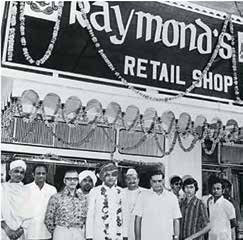Issue No.17 / November 1-15,2015

With its net revenue crossing Rs.5,000 crore, Raymond ranks 23rd amongst the most trusted brands in the country. Citizen Corporate looks at a brand that blends fine textile engineering and craftsmanship with visionary advertising that makes it the first choice for suiting fabric, even in the face of new players
In a society that values the Alpha Male over all else, here’s a fellow completely in touch with his softer side. Sometimes, a thoughtful husband, at others a doting father and still others, a chivalrous male—his appeal transcends boundaries of time and geography. Unafraid to show emotion, a man of few words, but whose actions speak for themselves, he enjoys a pan-Indian aspirational presence. He tells you it is entirely possible to mix masculinity with compassion and courtesy; you can be a man of the world, and yet Indian at heart. In short, he is the Complete Man, clothed in Raymond’s.
Never mind the onslaught of time, he continues to enjoy a whopper of a market share (pegged anywhere between 55 to 60 per cent) of the worsted textiles market, despite the presence of other names like Reid & Taylor and Siyaram’s—to say nothing of the increasing exposure to international brands like Saville Row, Polo Ralph Lauren and Armani.
From the rich to the upcoming middle class professional, the man-about-town to the bright young graduate, the groom-to-be or the father of the bride, the entrepreneur or the new dad—Raymond’s has a suit for them all

The Singhanias came on the scene in the forties when the noted industrial family of the Kanpur region and owner of the JK Group of Companies took over. The group, amongst other things, used to focus on textile dyes. They were looking to expand base in the lucrative Bombay zone. Raymond seemed the logical choice. Thus in 1944, Kailashpat Singhania took over the mill—keeping its name— and gradually building it into one of the premium names in the Indian textile and clothing industry
But Kailashpat did not stop there—he invested heavily in technology improvement in the 1950s, resulting in the creation of the fine Terool yarn in 1958. It was time to enter the retail market with a bang—with the launch of the company’s first showroom, the King’s Corner. (Does it ring a bell?)
Right through the fifties and sixties, the brand was positioned as a high-end product; gradually in the 70s, the ad focus was shifted to the ordinary man. However, the aspirational aura stayed, undisturbed.
The ’90s and 2000s created the ad persona of ‘the Complete Man’. The company later renamed its retail stores as ‘Raymond Shops’. At an approximate count there are over 650 Raymond shops across India, apart from 40 abroad. Its products are also housed in as many as 20,000 multi-brand outlets

However, it was Agarwal who told the story of the Complete Man like never before. “I wanted to create advertising with appeal across time zones,” he has been quoted at several points.
From 2002, RK Swamy of BBDO took over The Complete Man’s narrative.
It’s not just the Raymond man who’s the winner, but also his absolute absence of speech and his signature tune that makes him a favourite even on regional TV channels.
After all, some emotions are never lost in translation. (See box)
All through the march of time, and change in leadership (Vijaypat Singhania in the ’80s and ’90s, and now Gautam Singhania), one factor is a constant: the stress on research and development to come up with classy new fabric; lightweight and sturdy version of wool, suitable for India’s warm climate, at the same time, chock-a-block with aesthetic appeal. A case in point being the launch of the breakthrough Trovine fabric in 1968—a product that proved to the Indian fashion connoisseur that it is completely possible for wool to be worn on desi shores
Under Vijaypat, the company became a modern, technologically-advanced group and a textile producer even ready to take on the global players. Statistics state that by the mid-2000s, Singhania’s production had crossed 25 million metres of worsted fabric per year, placing it in the hallowed portals of the world’s top-three producers.
The Group owns apparel brands like Raymond, Raymond Premium Apparel, Park Avenue, Park Avenue Woman, ColorPlus and Parx. In addition, the Group also has business interests in readymade garments, designer wear, cosmetics and toiletries.
The Raymond story was first scripted with the establishment of the Wadia Woollen Mills in Thane in the early 1900s. The mill was taken over by the industrialist Sassoon family, based in Mumbai. It was the Sassoons who reincorporated the company as The Raymond Woollen Mill in 1925

What works big time in the brand’s favour is the unwavering brand loyalty it has acquired over generations—to say nothing of the comfort of continuity. Also, although there are so many other options, it can hold its own against the finest in the world. “Raymond is not just aspirational, but also solid value for money,” says a store manager in Pune’s upmarket Camp area. “We have several NRIs who take back two or three suits at a go. Similarly, buying or gifting a Raymond suit is a tradition in most Indian homes. Be it a wedding, or a son doing well on an exam, a new promotion or conference, every special occasion needs a Raymond suit,” he says
With the net revenue closed at Rs.5,428 crore in 2015 under Gautam Singhania, the brand continues to go from strength to strength. Take a bow, The complete Man
By Kalyani Sardesai